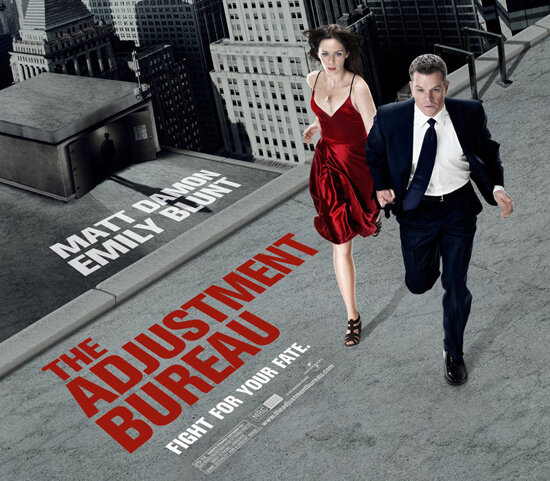
(Image: slashfilm.com)
Authority in Architecture: An In-Depth Look at The Adjustment Bureau
By Hannah Thayer
The concept of only being able to move a predetermined number of ways within buildings, and within life, is challenged in The Adjustment Bureau. The people in the adjustment bureau are able to defy what architecture is and how it rules us by traveling through space using only doors; they open a door and choose where it leads to. Architecture has no authority over them as they get to use buildings how they see fit and use them to their space-traveling advantage. The built environment can be very demanding and incredibly intimidating. This movie addresses the idea of what is out of our control and how far are we willing to go to get it, while using the built environment to emphasize just how small we really are in the grand scheme of things.
The Adjustment Bureau is about a man, David, in New York City who is trying to find a woman he met, Elise. David is running for Congress on an extremely successful platform while Elise is on the path to becoming an incredibly famous dancer. There seems to be some sort of “other” force trying to keep the man and woman apart, forcing them to participate in “adjusting” the world as they know it in order to stay together. The characters must face the fact that sometimes there are other forces dictating your life, forces that are bigger than you. This point is driven home using doors and the architecture within. The doors are used to jump from place to place, with the common metaphor of the doors equating to all the choices humans have. The architecture, specifically New York City architecture, relates to the idea of things that are bigger than us. The colossal buildings, the giant bridges, the huge, decorative rooms; everything about New York architecture makes people feel small in comparison.
Before becoming aware of the adjustment bureau, David was living his life like any other man in New York. His first interaction with the bureau happens when he shows up too early for work, a mistake that his adjuster was the cause of, and he sees the bureau in action. The people in his office seem to be frozen in time, with the bureau scanning his friend’s face and changing his mentality in order to keep him on track. The scene after that is David running through his office buildings. There are clips of long, dark hallways, stairs that seem to go nowhere, while the bureau appears at every turn he makes. The architecture is purposely shrinking in to make the space seem small to sell the fact that David has nowhere to go. In Figure 1, David is running into darkness at the end of the hallway while one of the bureau members is going through the door to jump space and show up where David is. There is an almost comical, casual nature in the authority figure’s movement compared to David’s frantic running.
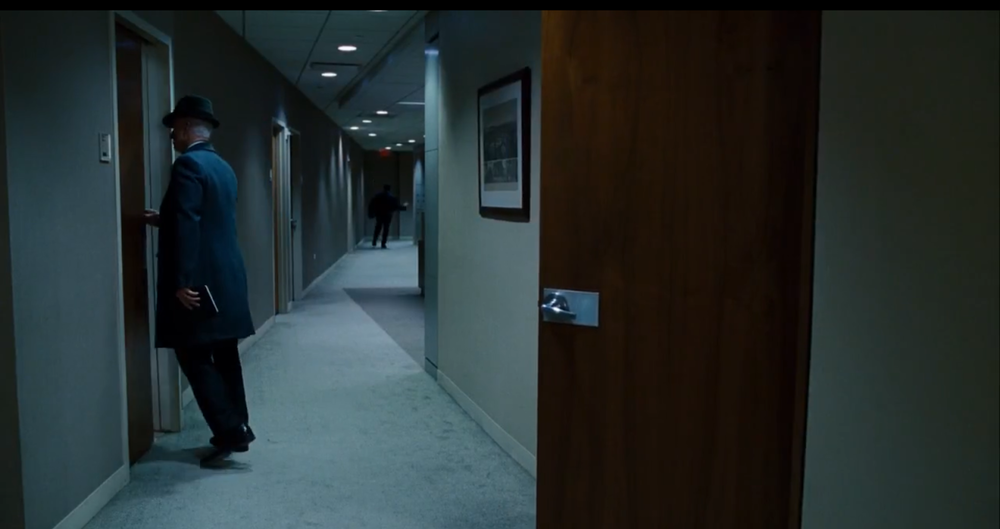
Figure 1
There are many different forms of power. French philosopher Michael Foucault “is one of the few writers on power who recognize that power is not just a negative, coercive or repressive thing that forces us to do things against our wishes, but can also be a necessary, productive and positive force in society” (Sussex University). This is the driving concept of the adjustment bureau and what they are trying to accomplish. If David had never seen what was behind the curtain, he would have continued to live his life as normal and benefit from the work the bureau was doing. They weren’t oppressing David or stifling his relationship with Elise for fun, it was just part of the bigger plan that they could never be successful if they stayed together. Until it was explained to David, he could only assume that they were bad people who just wanted to ruin his life and prevent him from loving Elise. After David was told why they were doing what they do and how they manage to have power, he chose to not acknowledge the authority they have and take back control. As much as we see outside forces exerting their power on us, we are ultimately the ones who decide how much power they have. Things only have as much power as we let them, and some people choose not to give up any of their own personal power. While there are always outside oppressive forces that hold people back, sometimes those forces do nothing compared to the inside authority we exert on ourselves.
Similarly to the built environment, humans have their own set of mental authority figures; sometimes this is our own voice, and sometimes we hear other people’s voices in our mental dialogue We all have our own personal limits, the walls we put up for protection from the outside and the doors we lock permanently behind us. In the film, when David gives in and leaves Elise at the hospital after the bureau hurts her while she is performing, he is giving in to the authority of his brain to let her have the future she wants. He allows for all the outside influences to convince him that she is better off without him and that her future will be best if he leaves her now. While all he wants is to be with her, and he is willing to give his own dreams up to have her, he is not going to force her to sacrifice her dreams. All of this comes to a head when David’s personal adjuster tells David about how the adjusters jump space and how David can beat the adjustment team. The bureau has special hats that they must be wearing in order to utilize doors to jump space. David chooses to defy authority when he puts on the bureau’s hat and uses doors as they do, choosing his heart over his head and starting a life with Elise. Elise in turn makes her own decision after David shows her how the doors work. She is incredibly overwhelmed, and when they open a door and appear at the base of the Statue of Liberty, she seems to want to stop and give up. Elise trusts David and she chooses to follow him through the door again, sealing her fate in working against the bureau (Fig. 2).
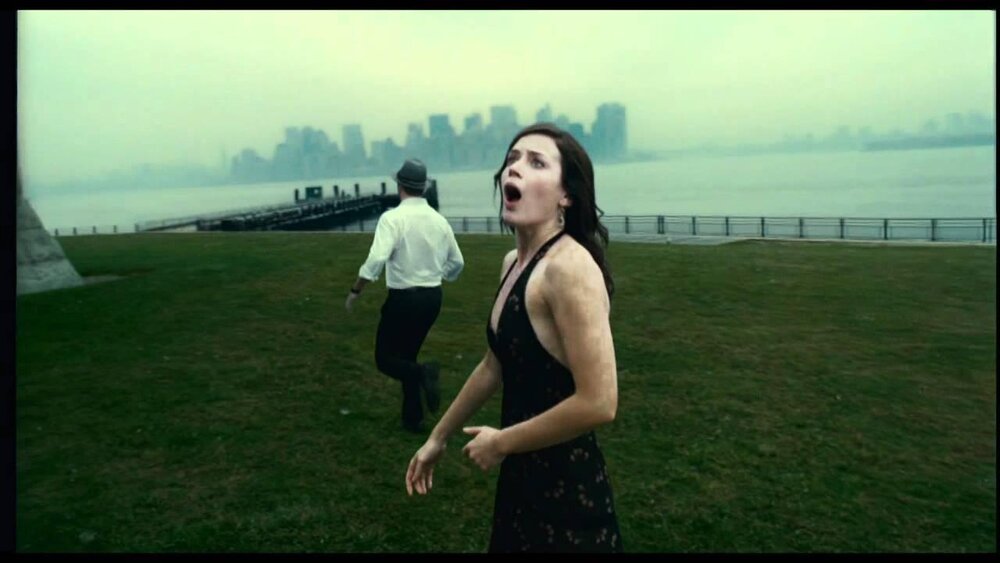
Figure 2
The ending scenes of the movie take us on David and Elise’s final confrontation with the adjustment bureau. We follow them through the bureau’s headquarters, filmed in the New York Public Library, and up the stairs to the roof of the building. No longer are David and Elise being dwarfed by the massive buildings that dominate New York’s skyline; they are instead on top of the building, becoming bigger than the way they were before as they take the power back in their lives. Figure 3 is from a scene where David is contemplating his life and his future. The shot is dark, almost abysmal, and the buildings are shown as towering over David with the camera looking down on him, making him look small to the viewer to drive home the point of him being powerless now. Figure 4 shows when David and Elise get to the rooftop of the bureau's headquarters. They realize that they have reached a physical end to their path, but the scene is shot from an almost eye-level angle with the city clearly below them, smaller. The idea of authority is shrinking, we no longer see David and Elise as dwarfed by things bigger than them, but rather two people who are regaining control. They are shot at almost eye level, bringing the viewer down to earth and making us almost at the same level as the couple. This scene is right before their future gets rewritten, and the power imbalance changes. Immediately after this scene, they kiss on the rooftop in front of the bureau and the sun breaks through the clouds, ending the pattern of gloominess. Their future is no longer dark; it now looks warm, inviting, and quite promising. The viewer finds out that the chairman, the head of the bureau, has decided to let David and Elise remain together. Their future is erased from the bureau’s books, and the authority figures leave the rooftop. Then in one of the final scenes, in Figure 5, the sun is out, and the camera is directly at eye level as we watch David and Elise walk down the street of New York City. We see the sides of the buildings, not the tops, as the couple is not dwarfed by the city anymore. No longer do David and Elise have something exerting power over them. Their future is blank, yet to written by them and them only. They have won.
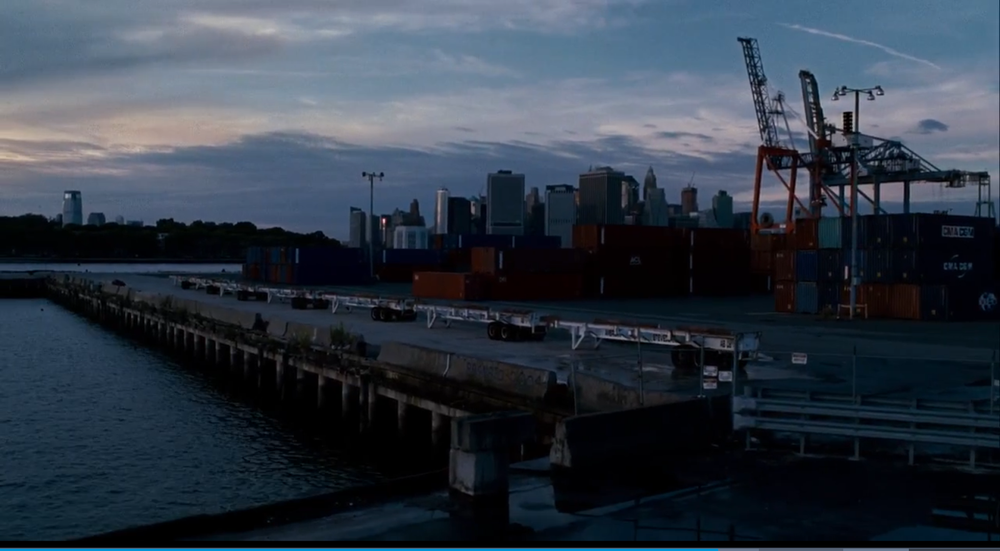
Figure 3
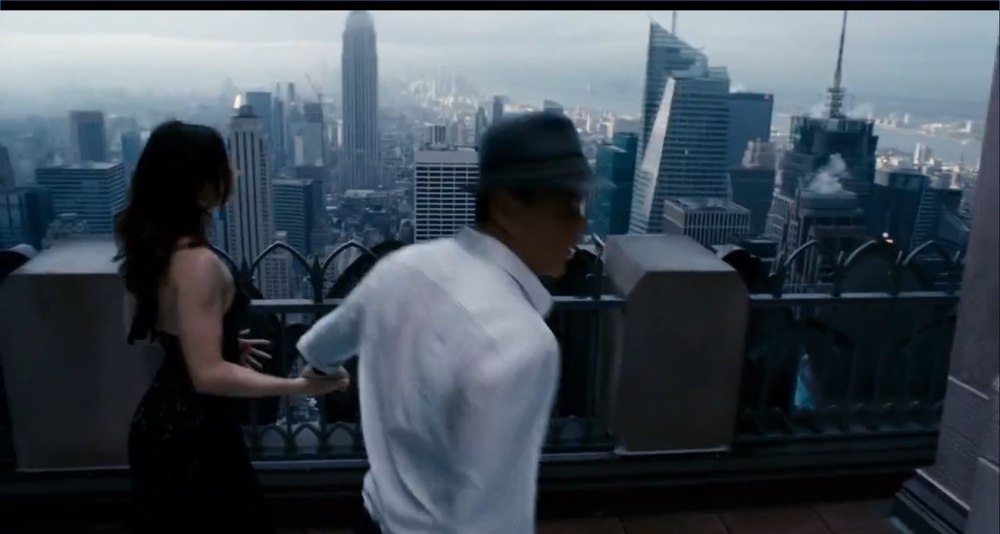
Figure 4
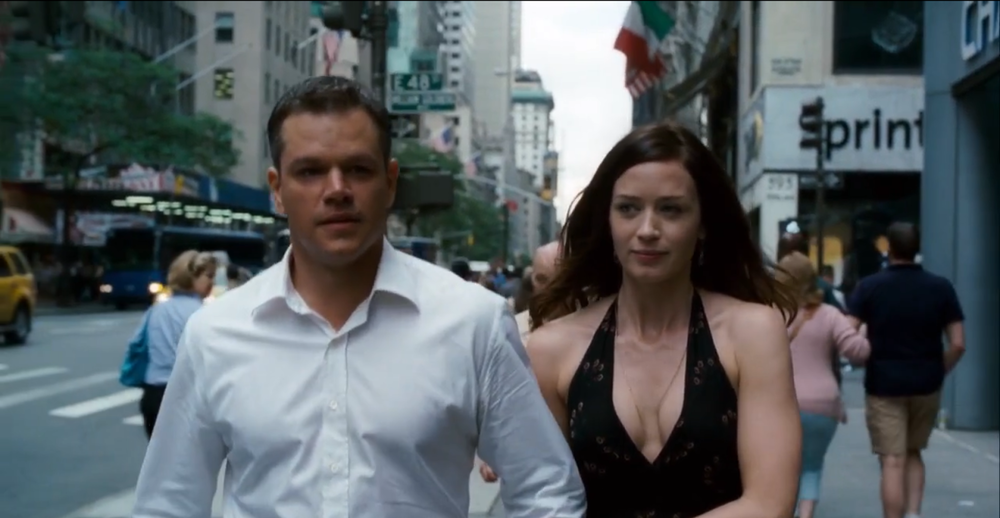
Figure 5
There are many parallels between humans and architecture. We are built the way we are built, humans have very little say in what our eyes can see or how our fingers hold things. We are built inside of a womb, with our parents’ DNA as the blueprints. We can choose to surgically change our bodies or learn a new language, but those are cosmetic changes that do not change the true integrity of the human. The same goes for buildings, they have plans and blueprints and are built the way they are built. There is a sense of authority within the original use that buildings have. The interior dictates how you can use the building. There are some choices, like which door you can use or whether to take the stairs or the elevator or which chair you want to sit in, but those are all limited by the building. You can only walk where the hallways are, you can only go through rooms using doors, there is no way to create your own path because humans cannot just go through walls. We respect the authority of the building because it seems we have no other choice.
Sources
The Adjustment Bureau, n.d.
Beckett, Katherine, and Steve Herbert. “Dealing with Disorder: Social Control in the Post-Industrial City.” Theoretical Criminology 12, no. 1 (February 2008): 5–30. doi:10.1177/1362480607085792.
Bradshaw, Peter. “The Adjustment Bureau – Review.” The Guardian. Guardian News and Media, March 3, 2011. https://www.theguardian.com/film/2011/mar/03/the-adjustment-bureau-review.
Catsoulis, Jeannette. “Metaphysical Red Tape Foils 'The Adjustment Bureau'.” NPR. NPR, March 4, 2011. https://www.npr.org/2011/03/04/134056418/metaphysical-red-tape-foils-the-adjustment-bureau.
Darwall, S. (2013). Authority and Reasons: Exclusionary and Second Personal. Morality, Authority, and Law, 151–167. doi: 10.1093/acprof:oso/9780199662586.003.0009
Denby, David. “Control Yourself.” The New Yorker. The New Yorker, June 19, 2017. https://ift.tt/35ltDCp.
Dovey, Kim. Framing Places: Mediating Power in Built Form. London: Routledge, 2008.
“Foucault: Power Is Everywhere.” Understanding power for social change powercubenet IDS at Sussex University Foucault power is everywhere Comments. Accessed October 14, 2019. https://www.powercube.net/other-forms-of-power/foucault-power-is-everywhere/.
Gillis, A. R., and John Hagan. “DENSITY, DELINQUENCY, AND DESIGN Formal and Informal Control and the Built Environment.” Criminology 19, no. 4 (1982): 514–29. https://ift.tt/2LYuql7.
Habraken, John. The Structure of the Ordinary: Form and Control in the Built Environment. Cambridge, MA: Mit Pr., 2000.
Hill, Jonathan. Actions of Architecture: Architects and Creative Users. New York: Routledge, 2003.
King, Anthony D. Buildings and Society: Essays on the Social Development of the Built Environment. London: Routledge Kegan Paul, 2003.
Lawrence, D. “The Built Environment And Spatial Form.” Annual Review of Anthropology 19, no. 1 (January 1990): 453–505. https://doi.org/10.1146/annurev.anthro.19.1.453.
Luther, Bryan A, and Jacqueline Jeziorski. “Adjusting Anthropomorphized Angels.” In Filming the Future: Essays on Science Fiction Cinema . Concordia College, 2012.
Novia, Laliyah Khairun, and Nurenzia Yannuar. “Chaos Theory As Depicted In The Adjustment Bureau.” Celt: A Journal of Culture, English Language Teaching & Literature 15, no. 1 (May 2016): 1. https://ift.tt/38GU8UN
Steve, and Weintraub. “Writer-Director George Nolfi Exclusive Interview THE ADJUSTMENT BUREAU.” Collider, September 25, 2019. https://ift.tt/1J6xvUQ.
Simmel, Georg. “The Metropolis and Mental Life.” Metropolis, 1995, 30–45. https://ift.tt/2PphQgP.

LOGO DESIGNED BY MEENTS ILLUSTRATED
from REVIEW BLOG - Every Movie Has a Lesson https://ift.tt/2EmZZAM







No comments:
Post a Comment